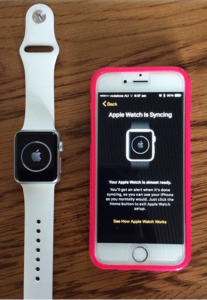We are finally getting more details on the Apple Watch display, now that the long coveted device has started trickling out in limited quantities (Mashable.com is reporting an Australian Fitness trainer was one of the first to receive hers on Friday April 24th.) Now DisplayMate Labs and principle researcher Dr. Ray Soneira offer a first-hand report on the new AMOLED screen with a full evaluation of its display performance. Perhaps the biggest news, is that the first ever AMOLED from Apple is a Retina-Class 312 x 390 pixel organic light emitting diode panel with 322 pixels per inch (ppi) using a sub-pixel RGB stripe. That 322 ppi is identical to the iPhone6 that offers the Retina (no discernible pixels) experience at viewing distances of 10.7″ or greater (with 20/20 vision).
To be sure, Apple isn’t coming out with much in the way of display specifications as it did with its other groundbreaking products. Soneira noted the company didn’t even provide some of the basics like screen size. Luckily the DisplayMate lab is well equipped, and Soneira “carefully measured” the 42mm Apple display screen at 30.8 x 24.6 mm (that’s 1.21″ x 0.97″) and a diagonal size of 38.7mm or 1.53″. Interestingly, the display is also in portrait mode with a 4:5 aspect ratio so it’s not square or rounded like most others devices in this category. Soneira reckons LG Display is the likely source for the display (now confirmed – iFixit Confirms Apple Watch Display Source – Man. Ed.). Look for the full shoot-out article on Displaymate.com
As with other fine watches, Apple also uses a sapphire crystal display cover glass making it almost totally scratch proof. But for this high scratch tolerance, the watch takes a display performance hit in reflectance, because sapphire reflects twice as much ambient light as glass. DisplayMate measured the Apple Watch’s optically-bonded sapphire cover glass reflectance at 8.2%. Compare this to the 4.6% for the glass on the iPhone 6. This directly affects daylight use of the device, and (because of the required boosted brightness) the watch also takes a battery life hit.
To that end, Apple also employs a “rather aggressive” power management strategy that, while helping extend the battery (for all day use?) can come in direct conflict with outdoor usability. Case in point, the watch display has a brightness of up to 482 cd/m², for very high ambient lit environments. There are three user setting for lighting, options the company gives to help strike a balance between the need to see the display and keep enough power to get through the day. Soneira notes that in some cases users will need to “…position your wrist into your shadow, in order to see the display well”.
That said, Soneira does note the Apple Watch benefits greatly from the use of OLED display technology that has the luxury of emitting pixels rather than using a back light and traditional LCD display. So a black background on the watch display with just a few pixels lit is much more power efficient using OLED. And battery life, usability concerns aside, Displaymate concludes that Apple has created “An Excellent Smart Watch Display… with pleasing and accurate colors and picture quality, and is a very good side-by-side match to the iPhone 6”.
There’s another interesting point about this Apple Watch OLED display. Back in early 2013 at an Apple investors conference, Tim Cook made headlines when he said, in essence, you can’t trust the color accuracy of (Samsung) OLED displays calling them “awful”. At the time this created a lot of ink in the press and most of us on the display side knew, he would probably come to regret those words. Perhaps now is the time for Cook to admit the benefits of OLED as the “technology du jour”. We’ll see. – Steve Sechrist

